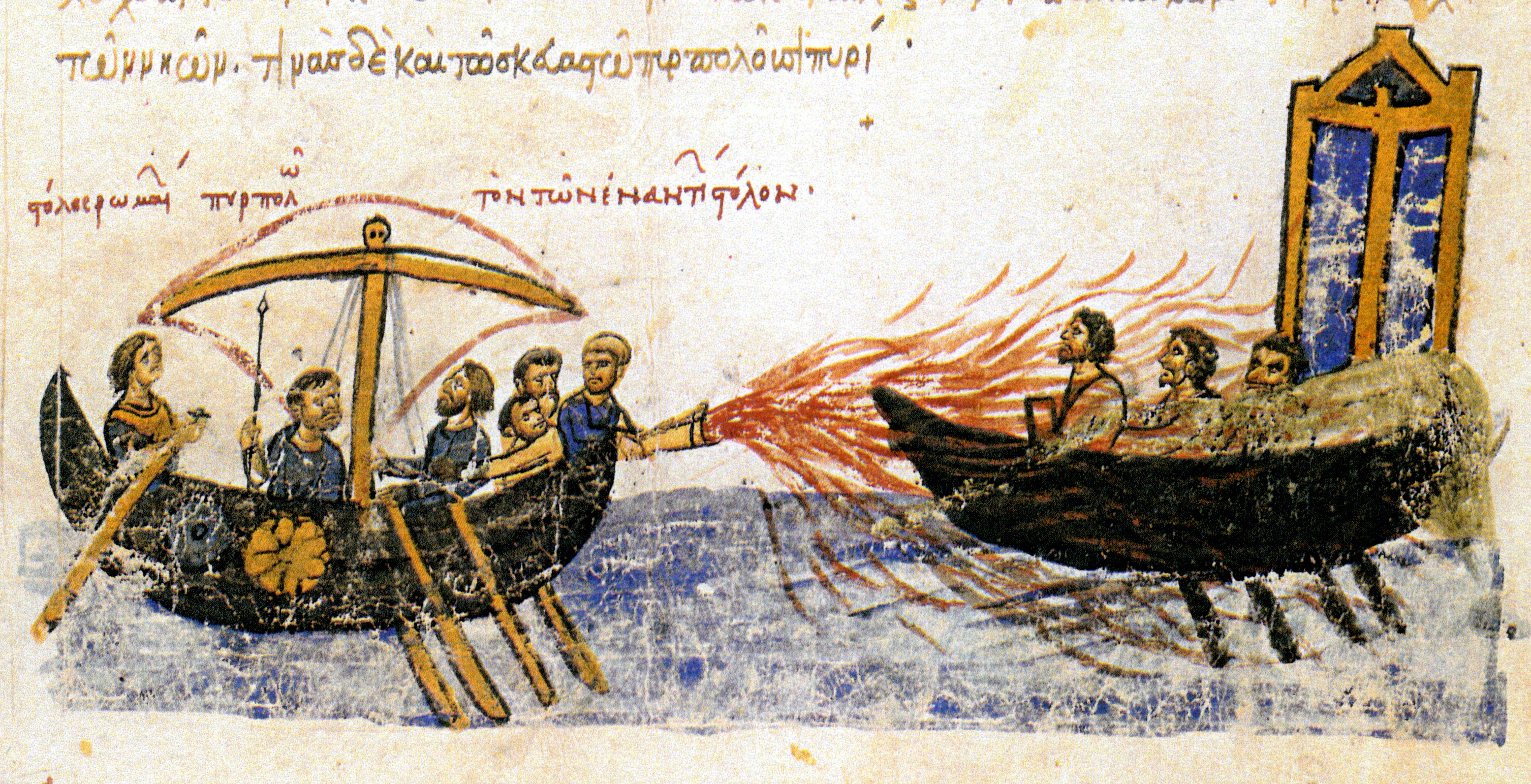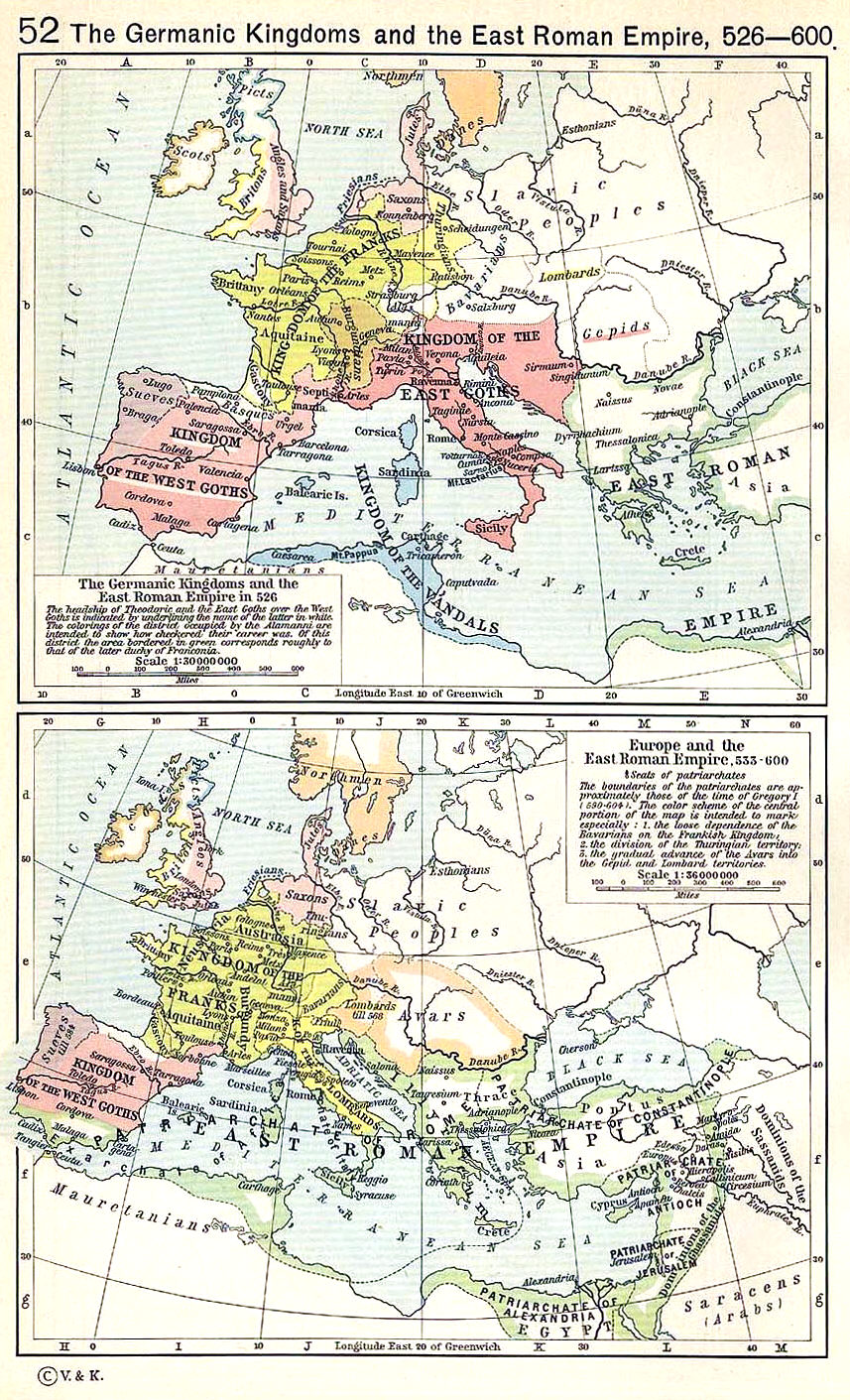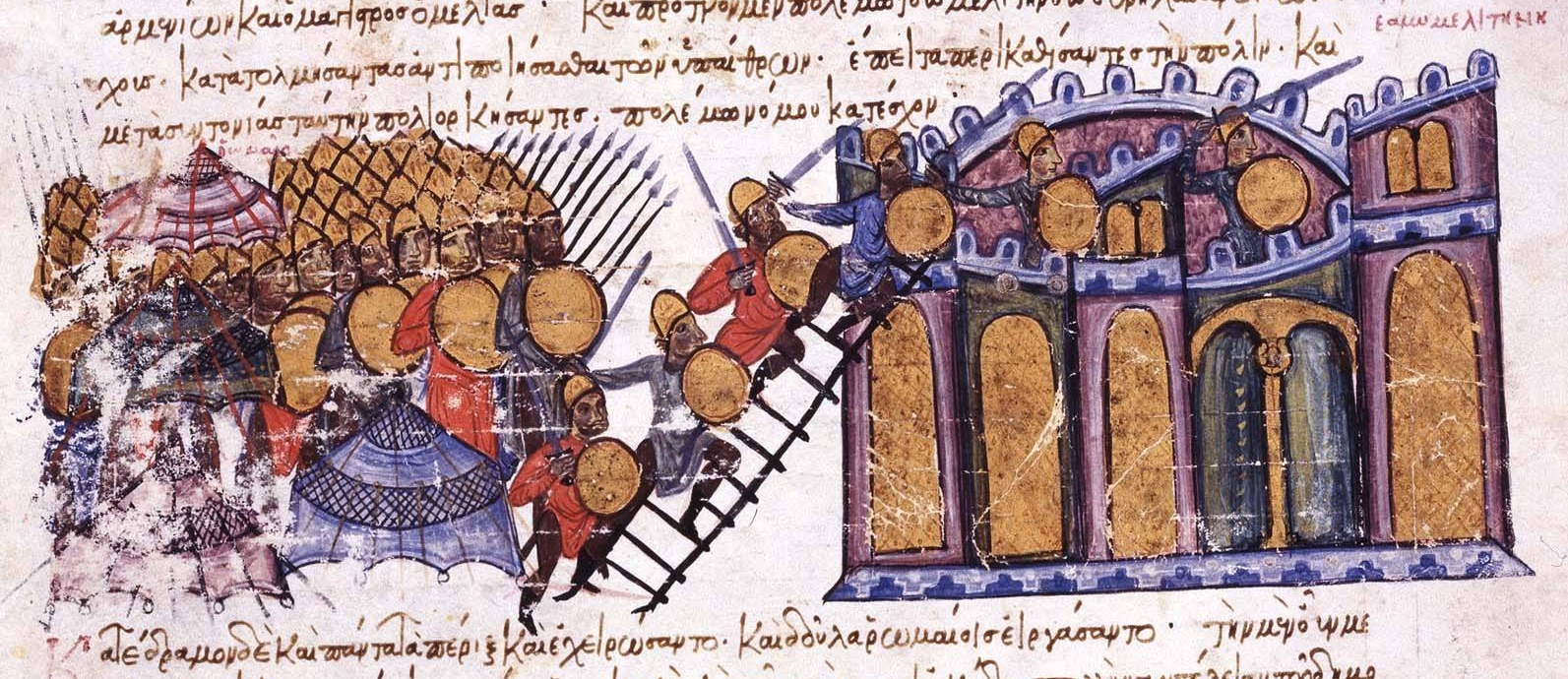|
941
Year 941 ( CMXLI) was a common year starting on Friday of the Julian calendar. Events By place Byzantine Empire * May – September – Rus'–Byzantine War: The Rus' and their allies, the Pechenegs, under the Varangian prince Igor I of Kiev, cross the Black Sea with an invasion fleet of 1,000 ships (40,000 men) and disembark on the northern coast of Asia Minor. While the Byzantine fleet is engaged against the Arabs in the Mediterranean, the Rus' forces reach the gates of Constantinople. Emperor Romanos I organizes the defense of the capital and assembles 15 old ships (equipped with throwers of Greek fire) under the chamberlain ('' protovestiarios'') Theophanes. The Byzantines repel the Rus' fleet (nearly annihilating the entire fleet) but can not prevent the invaders from pillaging the hinterland of Constantinople, venturing as far south as Nicomedia (modern-day İzmit). In September, John Kourkouas and Bardas Phokas ("the Elder"), two leading ge ... [...More Info...] [...Related Items...] OR: [Wikipedia] [Google] [Baidu] |
Theophanes (chamberlain)
Theophanes (, fl. ca. 925–945) was a Byzantine palace official and the chief adviser of Emperor Romanos Lekapenos (r. 920–944) during most of his reign. He was also an active and able diplomat, and led the naval defense of Constantinople against the Rus' invasion of 941. Biography Nothing is known of Theophanes's origin and early life. He first appears in the sources in October 925, as a ''protovestiarios'' in the court of Emperor Romanos I Lekapenos. In that month John Mystikos was dismissed in disgrace, and Theophanes took his place as ''paradynasteuon'', or chief imperial advisor. Unlike Mystikos, he proved both capable and loyal, and remained the chief figure of the government for the remainder of Romanos's reign.. At that time, the Byzantine Empire was embroiled in a protracted and disastrous war with Bulgarian Tsar Simeon (r. 893–927). In 927, however, Simeon died, and his infant son, Peter, ascended the Bulgarian throne under the regency of his uncle George Sur ... [...More Info...] [...Related Items...] OR: [Wikipedia] [Google] [Baidu] |
Romanos I Lekapenos
Romanos I Lakapenos or Lekapenos (; 870 – 15 June 948), Latinisation of names, Latinized as Romanus I Lacapenus or Romanus I Lecapenus, was Byzantine emperor from 920 until his deposition in 944, serving as regent for and senior co-ruler of the young Constantine VII. Origin Romanos derived his epithet Lekapenos, now usually treated as a family name, from his birthplace of Lakape (later Laqabin (West Syriac diocese), Laqabin) between Melitene and Samosata. It is found mostly as Lakapenos in the sources, although English-language scholarship in particular prefers the form Lekapenos, in large part due to Sir Steven Runciman's 1928 study on the emperor. He was the son of a peasant with the remarkable name of Theophylact "the Unbearable" (''Theophylaktos Abaktistos'' or ''Abastaktos''), who had rescued the Emperor Basil I from the enemy in battle at Tephrike in 872, saving his life, and had been rewarded by a place in the Imperial Guard and received estates as a reward.} Theophyla ... [...More Info...] [...Related Items...] OR: [Wikipedia] [Google] [Baidu] |
Igor Of Kiev
Igor (; ; – 945) was Prince of Kiev from 912 to 945. Traditionally, he is considered to be the son of Rurik, who established himself at Novgorod and died in 879 while Igor was an infant. According to the '' Primary Chronicle'', Rurik was succeeded by Oleg, who ruled as regent and was described by the chronicler as being "of his kin". Life Information about Igor comes mostly from the '' Primary Chronicle'', which states that Igor was the son of Rurik: 6378–6387 (870–879). On his deathbed, Rurik bequeathed his realm to Oleg, who belonged to his kin, and entrusted to Oleg's hands his son Igor', for he was very young. 6388–6390 (880–882). Oleg set forth, taking with him many warriors from among the Varangians, the Chuds, the Slavs, the Merians and all the Krivichians. He thus arrived with his Krivichians before Smolensk, captured the city, and set up a garrison there. Thence he went on and captured Lyubech, where he also set up a garrison. He then came to the hills o ... [...More Info...] [...Related Items...] OR: [Wikipedia] [Google] [Baidu] |
Black Sea
The Black Sea is a marginal sea, marginal Mediterranean sea (oceanography), mediterranean sea lying between Europe and Asia, east of the Balkans, south of the East European Plain, west of the Caucasus, and north of Anatolia. It is bounded by Bulgaria, Georgia (country), Georgia, Romania, Russia, Turkey, and Ukraine. The Black Sea is Inflow (hydrology), supplied by major rivers, principally the Danube, Dnieper and Dniester. Consequently, while six countries have a coastline on the sea, its drainage basin includes parts of 24 countries in Europe. The Black Sea, not including the Sea of Azov, covers , has a maximum depth of , and a volume of . Most of its coasts ascend rapidly. These rises are the Pontic Mountains to the south, bar the southwest-facing peninsulas, the Caucasus Mountains to the east, and the Crimean Mountains to the mid-north. In the west, the coast is generally small floodplains below foothills such as the Strandzha; Cape Emine, a dwindling of the east end ... [...More Info...] [...Related Items...] OR: [Wikipedia] [Google] [Baidu] |
Otto I, Holy Roman Emperor
Otto I (23 November 912 – 7 May 973), known as Otto the Great ( ) or Otto of Saxony ( ), was East Francia, East Frankish (Kingdom of Germany, German) king from 936 and Holy Roman Emperor from 962 until his death in 973. He was the eldest son of Henry the Fowler and Matilda of Ringelheim. Otto inherited the Duchy of Saxony and the kingship of the Germans upon his father's death in 936. He continued his father's work of unifying all German tribes into a single kingdom and greatly expanded the king's powers at the expense of the aristocracy. Through strategic marriages and personal appointments, Otto installed members of his family in the kingdom's most important duchies. This reduced the various dukes, who had previously been co-equals with the king, to royal subjects under his authority. Otto transformed the church in Germany to strengthen royal authority and subjected its clergy to his personal control. After putting down a brief civil war among the rebellious duchies, Otto de ... [...More Info...] [...Related Items...] OR: [Wikipedia] [Google] [Baidu] |
Greek Fire
Greek fire was an incendiary weapon system used by the Byzantine Empire from the seventh to the fourteenth centuries. The recipe for Greek fire was a closely-guarded state secret; historians have variously speculated that it was based on saltpeter, sulfur, or quicklime, but most modern scholars agree that it was based on petroleum mixed with resins, comparable in composition to modern napalm. Byzantine sailors would toss grenades loaded with Greek fire onto enemy ships or spray it from tubes. Its ability to burn on water made it an effective and destructive naval incendiary weapon, and rival powers tried unsuccessfully to copy the material. Name Usage of the term "Greek fire" has been general in English and most other languages since the Crusades. Original Byzantine sources called the substance a variety of names, such as "sea fire" (Medieval Greek: ), "Roman fire" ( ), "war fire" ( ), "liquid fire" ( ), "sticky fire" ( ), or "manufactured fire" ( ). History Incendiary and ... [...More Info...] [...Related Items...] OR: [Wikipedia] [Google] [Baidu] |
Arabs
Arabs (, , ; , , ) are an ethnic group mainly inhabiting the Arab world in West Asia and North Africa. A significant Arab diaspora is present in various parts of the world. Arabs have been in the Fertile Crescent for thousands of years. In the 9th century BCE, the Assyrians made written references to Arabs as inhabitants of the Levant, Mesopotamia, and Arabia. Throughout the Ancient Near East, Arabs established influential civilizations starting from 3000 BCE onwards, such as Dilmun, Gerrha, and Magan, playing a vital role in trade between Mesopotamia, and the Mediterranean. Other prominent tribes include Midian, ʿĀd, and Thamud mentioned in the Bible and Quran. Later, in 900 BCE, the Qedarites enjoyed close relations with the nearby Canaanite and Aramaean states, and their territory extended from Lower Egypt to the Southern Levant. From 1200 BCE to 110 BCE, powerful kingdoms emerged such as Saba, Lihyan, Minaean, Qataban, Hadhramaut, Awsan, and ... [...More Info...] [...Related Items...] OR: [Wikipedia] [Google] [Baidu] |
Byzantine Navy
The Byzantine navy was the Navy, naval force of the Byzantine Empire. Like the state it served, it was a direct continuation from its Roman navy, Roman predecessor, but played a far greater role in the defence and survival of the state than its earlier iteration. While the fleets of the Roman Empire faced few great naval threats, operating as a policing force vastly inferior in power and prestige to the Roman army, army, command of the sea became vital to the very existence of the Byzantine state, which several historians have called a "maritime empire". The first threat to Roman hegemony in the Mediterranean Sea was posed by the Vandals in the 5th century, but their threat was ended by the wars of Justinian I in the 6th century. The re-establishment of a permanently maintained fleet and the introduction of the dromon galley in the same period also marks the point when the Byzantine navy began departing from its late Roman roots and developing its own characteristic identity. Thi ... [...More Info...] [...Related Items...] OR: [Wikipedia] [Google] [Baidu] |
John Kourkouas
John Kourkouas (, ), also transliterated as Kurkuas or Curcuas, was one of the most important generals of the Byzantine Empire. His success in battles against the Muslim states in the East reversed the course of the centuries-long Arab–Byzantine wars and set the stage for Byzantium's eastern conquests later in the century. Kourkouas belonged to a family of Armenian descent that produced several notable Byzantine generals. As commander of an imperial bodyguard regiment, Kourkouas was among the chief supporters of Emperor Romanos I Lekapenos () and facilitated the latter's rise to the throne. In 923, Kourkouas was appointed commander-in-chief of the Byzantine armies along the eastern frontier, facing the Abbasid Caliphate and the semi-autonomous Arab Muslim border emirates. He kept this post for more than twenty years, overseeing decisive Byzantine military successes that altered the strategic balance in the region. During the 9th century, Byzantium had gradually recovered its ... [...More Info...] [...Related Items...] OR: [Wikipedia] [Google] [Baidu] |
Bardas Phokas The Elder
Bardas Phokas (; ) was a notable Byzantine general in the first half of the 10th century. He was the father of emperor Nikephoros II Phokas and the '' kouropalates'' Leo Phokas the Younger, and was also the maternal grandfather of the emperor John I Tzimiskes. His wife, daughter of Eudokimos Maleinos and a daughter of ''patrikios'' Adralestos, belonged to the Maleinoi, a powerful Anatolian Greek family which had settled in Cappadocia.: "The Maleinos lineage was among the members of the old byzantine aristocracy, emerging during the 9th century. It was a family of greek origin with close bonds to the region of Asia Minor. It has been presumed that the surname Maleinos is related to the name place Malagina of Bithynia, a location in the theme of Boukellarion during the 9th century. If one accepts that presumption, one should look for the old estates of the family in the fertile valley of the Sangarios river. It is safe, however, to consider the region of Charsianon as the homeland of ... [...More Info...] [...Related Items...] OR: [Wikipedia] [Google] [Baidu] |
Kievan Rus'
Kievan Rus', also known as Kyivan Rus,. * was the first East Slavs, East Slavic state and later an amalgam of principalities in Eastern Europe from the late 9th to the mid-13th century.John Channon & Robert Hudson, ''Penguin Historical Atlas of Russia'' (Penguin, 1995), p.14–16. Encompassing a variety of polities and peoples, including East Slavs, East Slavic, Norsemen, Norse, and Finnic peoples, Finnic, it was ruled by the Rurik dynasty, founded by the Varangians, Varangian prince Rurik.Kievan Rus , Encyclopædia Britannica Online. The name was coined by Russian historians in the 19th century to describe the period when Kiev was preeminent. At its greatest extent in the mid-11th century, Kievan Rus' stretched from the White Sea in the north to the Black Sea in the south and from the River source, headwaters of the ... [...More Info...] [...Related Items...] OR: [Wikipedia] [Google] [Baidu] |
Asia Minor
Anatolia (), also known as Asia Minor, is a peninsula in West Asia that makes up the majority of the land area of Turkey. It is the westernmost protrusion of Asia and is geographically bounded by the Mediterranean Sea to the south, the Aegean Sea to the west, the Turkish Straits to the northwest, and the Black Sea to the north. The eastern and southeastern limits have been expanded either to the entirety of Asiatic Turkey or to an imprecise line from the Black Sea to the Gulf of Alexandretta. Topographically, the Sea of Marmara connects the Black Sea with the Aegean Sea through the Bosporus and the Dardanelles, and separates Anatolia from Thrace in Southeast Europe. During the Neolithic, Anatolia was an early centre for the development of farming after it originated in the adjacent Fertile Crescent. Beginning around 9,000 years ago, there was a major migration of Anatolian Neolithic Farmers into Neolithic Europe, Europe, with their descendants coming to dominate the continent a ... [...More Info...] [...Related Items...] OR: [Wikipedia] [Google] [Baidu] |











